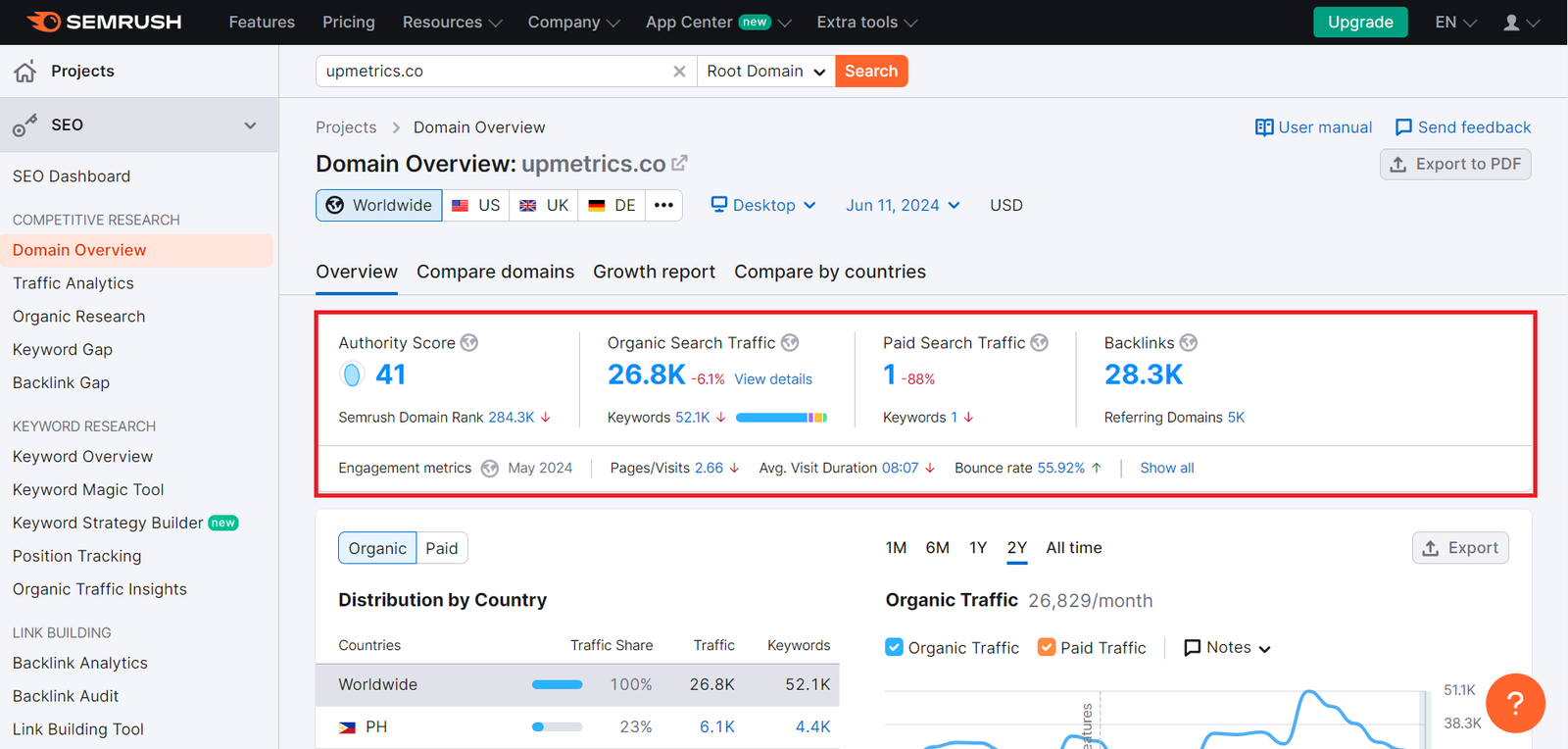Did you know that backlinks remain one of the most influential factors in how Google ranks your website?
In fact, a solid backlink profile can be the difference between obscurity and visibility in search results. As someone who’s navigated the turbulent waters of SEO and founded a website to help entrepreneurs thrive online, I can tell you that evaluating backlink opportunities is both an art and a science.
Today, I’ll walk you through my step-by-step process for determining if a website is worth getting backlinks from, drawing on my personal experience and insights gained from years of trial and error.
1. Start with Semrush Domain Overview

Have you ever wondered why some websites leapfrog over others in search results?
It often boils down to the quality of backlinks.
Here’s how you can begin:
- Take the Domain
- Put it on Semrush
- Go to Domain Overview
- Review Authority Score
By following these steps, you will gain a comprehensive overview of the domain.
2. Understand Authority Score
Authority Score is the metric I trust most when checking website authority.
Here’s why:
- Holistic Measure: Unlike Domain Rating (DR) and Domain Authority (DA) which focus solely on backlinks, the Authority Score in Semrush considers organic search traffic too.
- Reliability: Since it’s challenging to generate a genuine organic traffic, the Authority Score serves as a robust indicator of a website’s authenticity and influence.
Key Takeaway: Keep in mind that an Authority Score around 40 is commendable, although it typically lags behind DR. So, even if a site boasts a higher DR, delve deeper into its Authority Score for a clearer picture.
3. Analyze Traffic Metrics
Evaluating the organic traffic of a potential backlink source is crucial.
Here’s what to look for:
- Targeted Traffic: A real business, even with modest traffic, can be more valuable if it targets the right audience.
- Paid Traffic: If a site invests in Google Ads, it’s likely a legitimate business.
Example: I once evaluated a site with modest traffic but significant paid search investment. This indicated targeted, valuable visitors rather than random clicks.
4. Check Traffic Distribution by Country
When building links for the US market, the source’s traffic geography matters.
Key Insights:
- Top Traffic Sources: Ideally, the US should lead. If the top traffic sources are non-US countries, the backlink might not be as valuable for US-focused SEO.
- Avoid Irrelevant Sources: If you build links for the US market, you need to build them from websites that get organic traffic from the US, not from other countries, even if they are English-speaking.
Example: A site predominantly visited by US users is perfect for US-based clients. Conversely, I would avoid a site whose primary traffic comes from regions not aligned with my target demographic.
5. Review Organic Traffic Trends
Organic traffic trends provide insight into a website’s stability and performance over time.
Trend Analysis:
- Consistent or Growing Traffic Trends: Look for websites showing stable or increasing traffic patterns.
- Impact of Recent Google Updates: Understand how recent changes in Google’s algorithms have affected the site.
- Sharp Drops in Traffic: Avoid sites that have experienced sudden and unexplained decreases in traffic.
Example: A drop from 8,000 to 5,000 visitors might not be significant, but a steady downward trend could indicate underlying issues.
6. Check Relevance of Top Keywords
Keyword relevance is key.
Ensure the site’s top organic keywords align with its business:
- Avoid Irrelevant Keywords: Keywords like “Windows error” or “car plate number” for a business tool site are warning signs.
- Ensure Business Alignment: The keywords should match the site’s core offerings.
Example: A site focused on AI writing assistants should have keywords like “business plan writers” or “revenue growth calculator.” This alignment is crucial for link value.
7. Inspect the Backlink Profile
The quality of a site’s backlinks is a window into its overall SEO value:
- Quality Over Quantity: A few high-quality backlinks (e.g., from Forbes) outweigh numerous low-quality links.
- Avoid Link Farms: Be cautious of links from platforms like Blogspot, Medium, or Goodreads if used excessively.
Example: I encountered a site with a clean backlink profile, including a nofollow link from Forbes. Despite the nofollow attribute, the link added significant credibility.
8. Watch Out for Bad Practices
Some sites employ dubious tactics to inflate their metrics.
Here’s what to avoid:
- Secondary Blogs: Avoid links from secondary blogs with lower quality content.
- Irrelevant Topics: Steer clear of sites covering unrelated niches, especially if they accept guest posts indiscriminately.
Example: A site with an outdated design covered topics from business to gambling. This scattershot approach is a warning sign for SEO quality.
9. Trust Your Intuition
After all the data, let your gut guide you:
- Site Design and Usability: Professional design and features like live chat and customer reviews signal trustworthiness.
- Overall Feel: Sometimes, the overall impression of a site can be telling. Does it seem reputable and well-maintained?
Example: I rated a site an 8 out of 10 despite lower traffic because it had excellent design, genuine business operations, and credible backlinks.
10. Bad Example: What to Avoid
Finally, steer clear of websites that exhibit poor SEO practices:
- Outdated Design: If the site looks like it’s stuck in the 90s, it’s likely not well-maintained.
- Unrelated Content: Sites covering a mishmash of topics, like business, automotive, and gambling, are generally not good backlink sources.
- Excessive Backlinks for Sale: If a site openly sells backlinks or accepts guest posts from vastly different niches, it’s a red flag.
Example: I came across a website with a variety of niches, including gambling, which is usually rejected by reputable sites. Such links are unlikely to provide value.
Semrush Exclusive Offer
Are you ready to take your backlink strategy to the next level? As a special thank you for reading, I’m offering an exclusive 14-day free trial of Semrush through our partnership, instead of the usual 7 days. With Semrush, you can effortlessly check the Authority Score and other vital metrics to make informed decisions about your backlink sources. Don’t miss out on this exclusive offer – sign up now and empower your SEO strategy with the best tools available.
If you find Semrush as beneficial as I do, consider upgrading to a paid plan. By using my affiliate link, you’ll support my work, and I’ll earn a small commission at no extra cost to you.
Conclusion
Evaluating a website for backlinks involves a mix of data analysis and gut feeling. By focusing on authority scores, traffic metrics, geographic relevance, and backlink profiles, you can make informed decisions that bolster your SEO strategy.
Disclaimer: Some of the links above may be affiliate links, which means that if you click on them, I may receive a small commission. The commission is paid by the retailers at no cost to you, and this helps to support our channel and keep our videos free.

